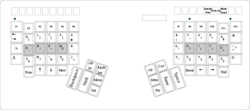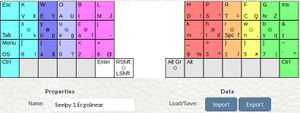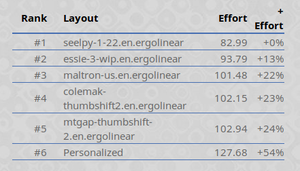Difference between revisions of "Ergonomic keyboard layouts"
(Arensito) |
(→BuT and BuT-XCV) |
||
| Line 28: | Line 28: | ||
* Optimized for matrix keyboards like ErgoDox or TrulyErgonomic | * Optimized for matrix keyboards like ErgoDox or TrulyErgonomic | ||
| − | * Bi- and trigram optimization, separated syllables. German-English 1: 1 | + | * Bi- and trigram optimization, separated syllables. German-English 1:1 |
| − | * | + | * More hand and finger alteration |
| − | * | + | * Shortcut buttons (X,C,V) are mirrored on the left half of the keyboard (BuT XCV) |
{{-}} | {{-}} | ||
| + | |||
==== PUQ ==== | ==== PUQ ==== | ||
{{infobox layout | {{infobox layout | ||
Revision as of 12:58, 21 April 2018
Contents
AdNW
BuT and BuT-XCV
 | |
| Creator | Multiple |
|---|---|
| License | "Public Domain" |
| Website | adnw.de |
| |
| |
| |
 | |
| Creator | Multiple |
|---|---|
| License | "Public Domain" |
| Website | adnw.de |
| |
| |
| |
- Optimized for matrix keyboards like ErgoDox or TrulyErgonomic
- Bi- and trigram optimization, separated syllables. German-English 1:1
- More hand and finger alteration
- Shortcut buttons (X,C,V) are mirrored on the left half of the keyboard (BuT XCV)
PUQ
 | |
| Creator | Multiple |
|---|---|
| License | "Public Domain" |
| Website | adnw.de |
| |
| |
| |
- Assignment for 30 character keys
- Umlauts and special characters are generated by Diakritika / Compose key
- Optimized for matrix keyboards, trigram optimization, separated syllables. German-English 1: 1
- Many hand changes, even finger strain, minimal collisions, round and fast
BEAKL
Advanced Keyboard Theory
BEAKL stands for Balanced Effortless Advanced Keyboard Layout. Its goals are as follows:
- Balance the workload between each hand and between the fingers and keys based on the fingers' strength and agility and the keys' potential for rolls and speed.
- Effortless means good rhythm in alternations and rolls, and getting a superior score in every keyboard metric, such as low distance, low penalties from same finger and same hands, etc. Possibly higher speed ceiling with less effort.
- Advanced in the sense that it challenges traditional theories of typing. It asserts the following reasonings:
- It does not advocate the so-called home row in touch typing. It vehemently avoids favoring the home pinky and the inside index key. The home pinky is extremely slow, weak, and uncomfortable to type. Instead, it strongly recommends the home block that consists of the ring, middle, and index fingers on the top, home, and bottom rows. These 9 keys form the core where the common letters (and sometimes punctuations) should be placed.
- Related to the above, the pinky and inside index columns workload must be minimized. Each of these columns should have no more than 5% of the total key presses. Together, the two pinkies should do no more than 10% of the work; the two inside index columns together should not have more than 10% of the work. The latter is because the index home column already does a lot of work, so the inside column usage should be minimized.
- The bottom ring and index keys are extremely fast and should not be avoided as other keyboard designers suggest. These can be sometimes up to 2x or faster than pressing the home pinky key.
- Up and down finger movement is much faster, allows smoother rolls, and causes less strain than side-to-side movement (caused by pinky and inside index keys, and also by unnatural staggered keyboard design.)
- The new theory can be summed up into an effort grid that rates the effort cost and roll potential of each key, pictured as follows. Lower values are better.
- Recommend additional layers that are accessed by modifiers like shift, alt-gr, and numlock, so that fingers stay in the home block, rather than reaching all over the keyboard for numbers and symbols. This reduces time looking for symbols, speeds up writing code and math equations, provides an efficient numpad, and eliminates the need for tenkey numpad on the far right side of a full standard keyboard (thereby shrinking the size of the keyboard and allows mouse to be comfortably closer to the body). (See images in sidebar.)
Comparison with other layouts
Despite not putting the most common letters on the home row, the BEAKL layout still beats the competition in tests that heavily favor and expect common letters on the home row. This is accomplished with smart placement of common letters in the home block as described above. Thus achieving great combination of hand alternation and rolls with low same finger and same hand penalties. Due to its balanced nature, it is best to test this layout against other layouts using ergonomic keyboards designed with straight columns if possible.
The distance scores may be skewed due to the unnatural slant of standard keyboards. Most importantly, distance is not as good indicator as the actual time to hit a key. As claimed above, keys hit by the non-pinky fingers outside the home row are hit faster than the home pinky; even though generally the home pinky is thought of having a better distance score, while other faster keys may be penalized.
Modifications to AdNW Optimizer to accommodate new theory:
- Effort scores for each key has been modified from AdNW's default to match the effort grid posted as shown above.
- Heavily favor inward rolls compared to outward rolls.
- Pinky target usage 2%, other fingers 15%.
- Shift keys moved to thumb row (instead of outside pinkies.)
- Opt defaults to 32 keys by adding 2 keys to the right side. So added -_ and /? and restricted them to outside the main 30 key block.
Results:
- Beats everything else in AdNW optimizer with my customizations by far. MTGAP is closest but still a huge margin. Everything else is far behind.
- Can compete head-to-head with MTGAP on other comparison tests using their own metric and effort values.
Amuseum
 | |
| Website | shenafu.com |
|---|---|
",WHM GCU.- | |
SOENL DTAIR | |
'(YVK BPF)X | |
Note: The Q, Z and J letters are placed outside the main-30 key area, ending up in locations determined by the keyboard used – standard or Kinesis Contoured.
The parentheses () turn into brackets with Shift activated.
The quote " and apostrophe ' signs turn into colon and semicolon, respectively, when Shifted.
The goals of Amuseum layout is to :
- balance the workload between each hand ,
- put common punctuation in the main block, even if that means putting rare letters outside ,
- mirror the keys for both hands. Notice vowels are mirrored and balanced on left and right hands, same with comma and period, and parentheses.
9 Matrix
 | |
| Website | shenafu.com |
|---|---|
JHOUK GCRFZ | |
QIEAY DSTNB | |
/,'.X WMLPV | |
Malt
 | |
| |
| |
|
Developed in conjunction with the two-handed Maltron physical keyboards.
The letter E is operated by one thumb. It is the most common letter in English, occurring in sequence with almost every other letter. There is major potential in giving E independence from the other fingers' movements. In fact, QWERTY with that one change would go a long way. In an optimized layout like this one, the change also clears another spot on the home-row where E would have been placed.
Malt puts priority the home and top rows, relegating rare keys to the bottom.
News from 1977 - somewhat sexist, says the keyboard weighs "only three pounds", and reassures you that it can be plugged into electric typewriters. It also cost $850, which in 2016 dollars is $2873.
Arensito
 | |
QL P FUDK | |
ARENB GSITO | |
ZW HJ VCYMX |
http://www.pvv.org/~hakonhal/main.cgi/keyboard
Also known as the Hallingstad layout. Arensito uses some unique punctuation arrangements, so they are not displayed above. Visit the link or check pictures for details.
Made by Håkon Hallingstad to suit the Kinesis Contoured and two-handed Maltron, though there is an adaptation for usage on standard keyboards too.
This layout is named after its home-row. The design intentions are as follows:
- Places the eight most used characters under your fingertips.
- Is the layout that minimizes the probability that you use the same finger twice (in succession).
- Is the layout that maximizes the probability for using neighbour fingers in succession (and keeps the probability of sequences like y-d or z-l diminishingly low). This lets the fingers strike diagraphs and trigraphs extremely fast.
- Keep the workload off the pinkies. Both pinkies press a button about 40% less than the other fingers.
Some punctuation and programming symbols are placed under the AltGr layer, where they are closer to the fingers' home position.
Advanced Developer's Dvorak
Also known as ADDvorak.
Keyboards that can be used with this layout are: any Japanese keyboard, Kinesis Contoured, Kinesis Freestyle, Maltron, Data Hand.
Created by freelance developer Andrei Stanescu, this layout is something out of the ordinary. It is only a Dvorak layout in the sense that almost all the letters are operated by the same fingers as they are in Dvorak.
At the outset, this layout relies on the concept that modifier-combinations are preferred over faraway keys.
Towards this purpose, there are six modifier states on top of the normal state. There are no utilised keys at all beyond the main home-key cluster of 3x4 for each hand. At least two thumb-keys are required for each hand.
Workman
QDRWB JFUP;
ASHTG YNEOI
ZXMCV KL,./
Created by OJ Bucao, it's a layout particularly made for straight-column keyboards.
The design crux is that of keeping the fingers to their main 4 columns per hand and de-prioritising columns in the middle and to the sides, thus minimizing diagonal and lateral movement.
Should be very suitable for a Kinesis Contoured-type of keyboard – the author also uses this.
Ergolinear Split-case designs
Following the development of the Ergolinear form factor, the developers Ian Douglas and Xay Voong continued with their attempts to reach layout nirvana.
As is common in this field, inventors work with frequency charts of letters, bigrams, trigrams, etc. in an attempt to find a better layout.
The typical letter frequency order for English is usually a variation of this order, from Michael Dickens:
SPC etaoinsrhldcumfgpyw ENT b,.vk-"_'x)(;0j1q=2:z/*!?$35>{}49[]867\+|&<%@#^`~
But this is not the whole story. One day, Ian stumbled across a frequency chart taken from a large American corpus, which looked like this:
etaoinsrhldcumpfg.ywb-,v0k1TAIS2C'"/3ED9:MN=RP;4OB5)L(HFx8W67G_UjqzJ<?Y@*VK!|$~[]%X&+#QZ}{>`\^
Apart from some order difference, the biggest difference was the separation of uppercase and lowercase letters. It suddenly dawned on him that we type mostly lower case letters, and so we should optimise for that. This insight, together with the use of Arensito-style AltGr, led to the birth of the split-case design, where the upper case for a letter is on a different key to its lower case version.
Ideally, the optimising should work strictly according to frequency, but as a help, Ian decided to be a little less optimal, and split the keyboard into three main rows:
- Capital letters
- Lower case letters
- Punctuation and digits.
This led to the acronym C - L - P which was turned into the word Seelpy, as a name for this type of layout.
The initial version (Seelpy 1) looks like this:
Ian further refined this layout until it became unbeatable on Den1 scoring on KLA.
However Xay decided to pursue full optimisation, which entails mixing uppercase, lowercase, punctuation and digits, to achieve the best score.
This version of the Split Case came to be called Essie, from the acronym S - C. Alternative names use CLP even though this no longer implies strict separation by row.
A version of such a layout looks like this:
A comparison of scores, using Alice Chapter One on KLA: (higher is better)
A comparison of scores, using Alice Chapter One on Den1 scoring of KLA: (lower is better)
These layouts may be too difficult to use in practice.






